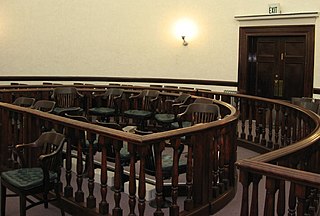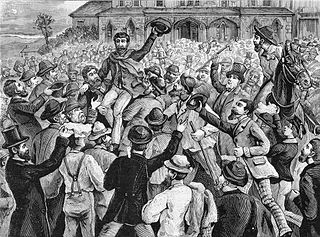Related Research Articles
In jurisprudence, double jeopardy is a procedural defence that prevents an accused person from being tried again on the same charges following an acquittal or conviction and in rare cases prosecutorial and/or judge misconduct in the same jurisdiction. Double jeopardy is a common concept in criminal law - in civil law, a similar concept is that of res judicata. The double jeopardy protection in criminal prosecutions only bars an identical prosecution for the same offence, however, a different offence may be charged on identical evidence at a second trial. Res judicata protection is stronger - it precludes any causes of action or claims that arise from a previously litigated subject matter.

A jury trial, or trial by jury, is a legal proceeding in which a jury makes a decision or findings of fact. It is distinguished from a bench trial in which a judge or panel of judges makes all decisions.
A plea bargain is an agreement in criminal law proceedings, whereby the prosecutor provides a concession to the defendant in exchange for a plea of guilt or nolo contendere. This may mean that the defendant will plead guilty to a less serious charge, or to one of the several charges, in return for the dismissal of other charges; or it may mean that the defendant will plead guilty to the original criminal charge in return for a more lenient sentence.

The Sixth Amendment to the United States Constitution sets forth rights related to criminal prosecutions. It was ratified in 1791 as part of the United States Bill of Rights. The Supreme Court has applied all but one of this amendment's protections to the states through the Due Process Clause of the Fourteenth Amendment.

A jury is a sworn body of people (jurors) convened to hear evidence, make findings of fact, and render an impartial verdict officially submitted to them by a court, or to set a penalty or judgment.

In common law jurisdictions, an acquittal means that the prosecution has failed to prove that the accused is guilty beyond a reasonable doubt of the charge presented. It certifies that the accused is free from the charge of an offense, as far as criminal law is concerned. The finality of an acquittal is dependent on the jurisdiction. In some countries, such as the United States, an acquittal prohibits the retrial of the accused for the same offense, even if new evidence surfaces that further implicates the accused. The effect of an acquittal on criminal proceedings is the same whether it results from a jury verdict or results from the operation of some other rule that discharges the accused. In other countries, like Australia and the UK, the prosecuting authority may appeal an acquittal similar to how a defendant may appeal a conviction — but usually only if new and compelling evidence comes to light or the accused has interfered with or intimidated a juror or witness.
Holmes v. South Carolina, 547 U.S. 319 (2006), was a decision by the United States Supreme Court involving the right of a criminal defendant to present evidence that a third party instead committed the crime. The Court vacated the rape and murder conviction in South Carolina of a man who had been denied the opportunity to present evidence of a third party's guilt, because the trial court believed the prosecutor's forensic evidence was too strong for the defendant's evidence to raise an inference of innocence. The Court ruled unanimously that this exclusion violated the right of a defendant to have a meaningful opportunity to present a complete defense, because the strength of a prosecutor's case had no logical relationship to whether a defendant's evidence was too weak to be admissible.

The Fifth Amendment to the United States Constitution creates several constitutional rights, limiting governmental powers focusing on criminal procedures. It was ratified, along with nine other articles, in 1791 as part of the Bill of Rights.
Heath v. Alabama, 474 U.S. 82 (1985), is a case in which the United States Supreme Court ruled that, because of the doctrine of "dual sovereignty", the double jeopardy clause of the Fifth Amendment to the Constitution does not prohibit one state from prosecuting and punishing somebody for an act of which they had already been convicted of and sentenced for in another state.
The Double Jeopardy Clause of the Fifth Amendment to the United States Constitution provides: "[N]or shall any person be subject for the same offence to be twice put in jeopardy of life or limb..." The four essential protections included are prohibitions against, for the same offense:
Ashe v. Swenson, 397 U.S. 436 (1970), was a decision by the United States Supreme Court, which held that "when an issue of ultimate fact has once been determined by a valid and final judgment, that issue cannot again be litigated between the same parties in any future lawsuit." The Double Jeopardy Clause prevents a state from relitigating a question already decided in favor of a defendant at a previous trial. Here, the guarantee against double jeopardy enforceable through the Fifth Amendment provided that where the defendant was acquitted of robbing one victim, the government could not prosecute the criminal defendant in a second trial for a different victim in the same robbery.
Griffin v. California, 380 U.S. 609 (1965), was a United States Supreme Court case in which the Court ruled, by a 6–2 vote, that it is a violation of a defendant's Fifth Amendment rights for the prosecutor to comment to the jury on the defendant's declining to testify, or for the judge to instruct the jury that such silence is evidence of guilt.

The Italian Code of Criminal Procedure contains the rules governing criminal procedure in every court in Italy. The Italian legal order adopted four codes since the Italian Unification. After the first two codes, in 1865 and 1913, the Fascist Government established in 1930 a new code adopting an inquisitorial system. In 1988 the Italian Republic adopted a new code, that could be considered to be somewhere in between the inquisitorial system and the adversarial system.
Plea bargaining in the United States is very common; the vast majority of criminal cases in the United States are settled by plea bargain rather than by a jury trial. They have also been increasing in frequency—they rose from 84% of federal cases in 1984 to 94% by 2001. Plea bargains are subject to the approval of the court, and different States and jurisdictions have different rules. Game theory has been used to analyze the plea bargaining decision.
A citizen's right to a trial by jury is a central feature of the United States Constitution. It is considered a fundamental principle of the American legal system.

The United States Constitution contains several provisions regarding the law of criminal procedure.
Glasser v. United States, 315 U.S. 60 (1942), was a landmark decision of the US Supreme Court on two issues of constitutional criminal procedure. Glasser was the first Supreme Court decision to hold that the Assistance of Counsel Clause of the Sixth Amendment required the reversal of a criminal defendant's conviction if his lawyer's representation of him was limited by a conflict of interest.
Taylor v. Illinois, 484 U.S. 400 (1988), is a United States Supreme Court decision in which the Court held that defense witnesses can be prevented from testifying under certain circumstances, even if that hurts the defense's case. Taylor was the first case to hold that there is no absolute bar to blocking the testimony of a surprise witness, even if that is an essential witness for the defendant, a limitation of the broad right to present a defense recognized in Washington v. Texas (1967).
As one of the fifty states of the United States, California follows common law criminal procedure. The principal source of law for California criminal procedure is the California Penal Code, Part 2, "Of Criminal Procedure."
Hemphill v. New York, 595 U.S. ___ (2022), was a decision by the United States Supreme Court involving the application of Confrontation Clause of the Sixth Amendment to the United States Constitution. In its decision, the Court ruled on when a criminal defendant who opens the door to otherwise inadmissible evidence also opens the door to evidence that would otherwise be excluded by the Confrontation Clause.
References
- ↑ "FRCRMP - Rule 7 (LII 2003 ed.)". www.law.cornell.edu. Archived from the original on 2003-05-05.
- ↑ https://www.oyez.org/cases/1970-1979/1970/1970_69_5046 [ bare URL ]
- ↑ https://www.oyez.org/cases/1970-1979/1970/1970_69_5035 [ bare URL ]
- ↑ https://www.oyez.org/cases/1970-1979/1978/1978_78_90 [ bare URL ]
- ↑ "US Sentencing Commission". Archived from the original on August 12, 2006. Retrieved August 9, 2006.